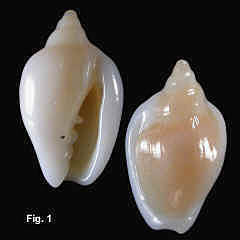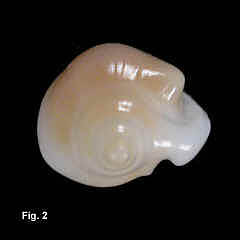|
|
|
|
|
Austroginella muscaria (Lamarck, 1822) Diagnosis: Shell moderately large; white to pale yellowish orange; strongly narrowed anteriorly; spire medium height with shouldered whorls; strong nodule or axial fold on body whorl just before varix; aperture broad; lip smooth, rapidly thickening posteriorly with sharply defined posterior notch, bordered by a parietal nodule; external varix present; siphonal notch present; heavy ventral callus; columella with four strong plaits occupying more than half the aperture. Size: Adults 10-16 mm in length. Distribution: Australian
Museum Collection: Ballina, NSW, to Comparison: This is the largest of the marginellids in NSW. Smallest specimens are around 10 mm in length, which is larger than the other species of the family. (See Identification of beach specimens). Remarks: This species, along with A. johnstoni, has a callus applied to all of the ventral surface, and a callus nodule or ridge beside the posterior notch this defining the posterior canal. On the dorsal surface, there is a prominent nodule or fold before the varix. Both features can be seen in Fig. 2, a view from the spire. Figs. 1,2: Nadgee, NSW (C.091592) |

